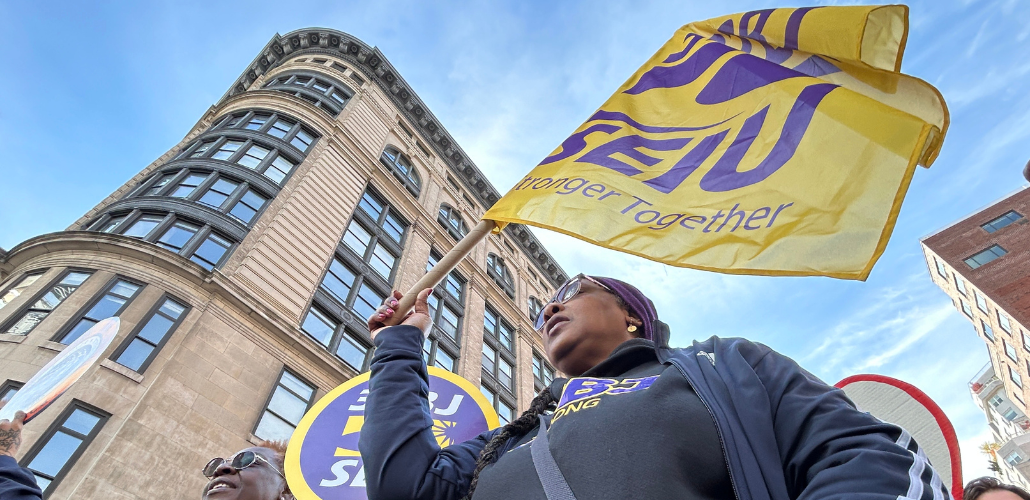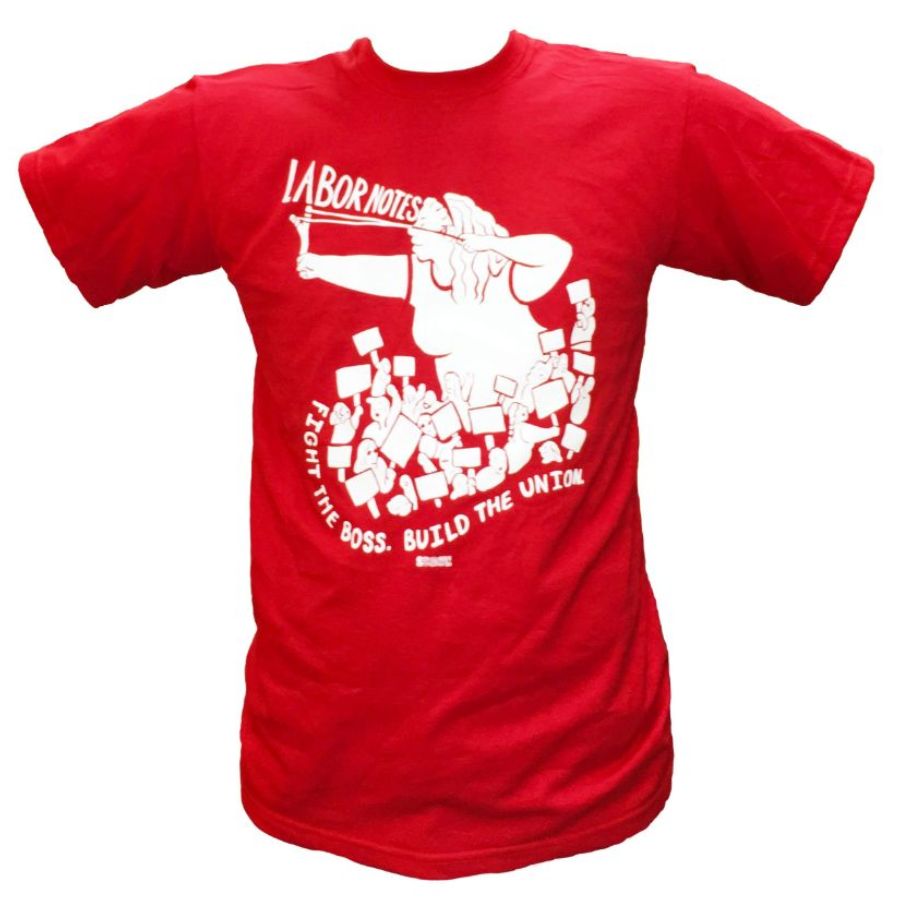Bring Your Union Banner to the Protest

Airport worker Sophia Harris, a shop steward in 32BJ SEIU, brought photos back to her workplace from the No Kings protest to help her co-workers catch the inspiring spirit of the massive turnout and break through their fear. Photo: 32BJ SEIU
Nearly 7 million people hit the streets October 18 to oppose Trump’s authoritarian actions. Demonstrators waved American flags and donned whimsical animal costumes. One sight we were especially glad to see in the crowds: union T-shirts, banners, and slogans.
In New York City, among the throng of 100,000 people were thousands of union members—teachers, nurses, federal workers, telecom workers, laborers, porters, and academic faculty. Certified nursing assistants and homecare workers with SEIU1199 sang and waved signs that read: “We Fight for Each Other. They Enrich Themselves!”
Good: Wearing your union T-shirt to the protest. Better: Bringing a whole group in union shirts, with your union banner. Better still: Getting your union to publicize the protest and turn members out.
Solidarity is what unions are all about. Here are a few reasons why it’s a great idea to bring your union identity—and your union—to the struggle:
1. More people show up.
Active local unions know how to do turnout—rallies and picket lines are our movement’s bread and butter, and (hopefully) we keep our phone lists up to date. The union can get the word out to people who might not even have heard about a protest otherwise. Plus, an invitation to join your fellow members and represent the union may feel more appealing and relevant than being an anonymous face in the crowd.
Verizon worker Dominic Renda said he came out to No Kings because a co-worker texted him. Renda has been a member of Communications Workers Local 1101 for 30 years, and he says that’s a practice he and his co-workers maintain to stay engaged in their union.
2. You can meet like-minded union members.
The simple question “What brought you out today?” is great way to kick-start a conversation. “What are you doing next?” is another good one. And if you spot someone you don’t know wearing the same union shirt as you, just go introduce yourself. Ask about where they work and the issues there.
Good organizers wear many hats. I (Luis) was wearing two at the No Kings march: reporter and member of the National Writers Union. When my phone was dying and I couldn’t continue interviewing people or snapping photos, Natalie James, president of the Legal Services Staff Association (UAW Local 2320) offered a portable charging station, and Renda supplied a cord that fit my charging jack. We ended up talking about a case of employer retaliation and the broader climate of impunity Trump has created.
Perhaps you are better-organized than a hapless journalist who goes to a protest with his phone battery nearly dead. But don’t wait for a serendipitous mishap to create an excuse to strike up a conversation. You can go prepared with a few questions and resolve to talk to two people you don’t already know.
Federal worker Linh Nguyen, who attended the No Kings rally in Philadelphia, has been talking with her co-workers across the American Federation of Government Employees all year to organize against retaliation and save the public’s services.
They discovered they shared more than a common foe. “We had been siloed into locals and chapters, and we didn’t realize how much we shared around workplace issues,” said Nguyen. She and her co-workers began participating in calls organized by the scrappy Federal Unionists Network, and attended days of action together.
“FUN was the catalyst for everything, and it introduced us to Labor Notes,” she says. That planted a seed: transforming AFGE Local 62 into a fighting union. Today Nguyen and her co-workers are supporting a reform slate that is challenging the incumbent local leaders in a November election.
3. It opens the door to conversation about what more the union can do.
After the New York march, members of the Organization of Staff Analysts (city employees) got together in their union hall to talk over pizza. Members shared why they had decided to participate: to pay it forward, to defend benefits and the right to collective bargaining.
“One member said she almost didn’t go but was phonebanked and remembered the Martin Neimoller poem (“First they came…”). She felt she had to go,” wrote member David Duhalde on Facebook. “Others talked about ICE, the need to fight Trump, and just how important being together was for their spirit and desire to push back against the political situation.”
They left the meeting with ideas for getting more involved in their union to prepare for possible federal funding cuts, and to reform the state’s pension system. It was “a truly democratic moment during rising authoritarianism,” said Duhalde, who saw the rally as “a dress rehearsal to prepare for attacks on New York City from D.C.” Greg Gabrellas, a psychiatrist in the Doctors Council SEIU, saw the Facebook post and decided to do the same thing with members at his union hall.
4. It opens the door to workplace conversation.
JFK airport worker Sophia Harris, a 32BJ SEIU member in New York, had watched on TV in June when SEIU rallied at city halls around the country to demand the release of Los Angeles union leader David Huerta. (He had been arrested for observing a workplace immigration raid, and is now facing misdemeanor charges.) When she heard about the rally from a union rep, it bolstered her resolve to participate.

SUPPORT LABOR NOTES
BECOME A MONTHLY DONOR
Give $10 a month or more and get our "Fight the Boss, Build the Union" T-shirt.
Harris’s mother saw the news, too—and drew a different lesson. “She knew that I’m very involved with the union,” Harris said. “She literally begged me: ‘Don’t get involved. Be behind the scenes.’ Mom, it’s no problem, because what has to happen will happen. So I can’t be afraid. But my thing is, you have to be bold.”
Harris, a shop steward, was the only person from her workplace to attend No Kings in October. “I made it my point of duty to take pictures, because saying something is one thing, but pictures speak volumes,” she said. She used her selfie stick, so her co-workers could see the size of the crowds, the banners, and the slogans on the signs.
When she got back to work, she spoke about the issues on people’s minds: the crackdowns on free speech, the cuts to health care, the abductions of immigrant workers. Her co-workers were afraid, but as they saw the photos and talked through the issues, Harris said she saw their body language perk up and their faces brighten. No one has signed up yet for the next action, but she plans to keep talking.
“If you stay in that little cocoon of fearfulness, you know that that doesn’t help your journey,” Harris said. “You have to get out and make a difference. Be a part of the action.”
5. Other workers see you and get inspired.
As 1199SEIU staffers were checking off names on sign-in sheets at the No Kings march, they noticed a group they didn’t recognize from the usual activist core of delegates or members on release time.
The newcomers turned out to be nonunion Spanish-speaking homecare workers from the Bronx, some still wearing their scrubs. When a union staffer approached them, one of the bilingual workers translated that they had come to the march because the homecare bosses are exploiting migrants, and it’s not right. They asked if they could wear purple 1199SEIU shirts too.
6. Ultimately we need economic disruption, and unions are best equipped to organize it.
As thousands of protestors filled Times Square, they disrupted some tourist attractions: “Nothing’s happening for us,” a ticket agent told the Wall Street Journal. The protest began at 47th Street and 7th Avenue, where bus tours typically begin.
Imagine if unions and No Kings organizers coordinated to plan protest walkouts during the workday, instead of on the weekends. The impact on business as usual would be a lot larger.
United Auto Workers President Shawn Fain has called for unions to align contract expirations for a season of strikes and other labor actions, starting May 1, 2028. Chicago Mayor Brandon Johnson spoke at a No Kings rally and called for a national general strike. Association of Flights Attendants-CWA President Sara Nelson, at the D.C. No Kings march, also raised the possibility.
“The flight attendant union, just [like] in 2019, is looking very carefully about when this system is going to break, because it will break, and planes will stop and people will not be able to get anywhere,” Nelson told the Real News Network, holding a sign that read: “Defend Democracy: It’s Time for a General Strike.” In 2019, her call for a general strike, combined with actual sickouts by air traffic controllers, helped bring a government shutdown to an end.
In a national follow-up call to debrief No Kings Day, organizers in the network of progressive organizations backing the rallies said the next steps could include disruptions; they have floated a range of actions, from boycotts to strikes.
For international inspiration: right now New Zealand is being rocked by coordinated strikes involving 100,000 workers across five different unions. Teachers, nurses and public employees unions are on the march.
7. Labor participation widens the goals.
Clearly the anti-Trump “no kings” message of defending democracy brought out millions of people. And also, many working-class people place just as much emphasis on the immediate emergencies in their own workplaces and neighborhoods—and many see Trump’s attacks as intensifying a crisis that was already underway, so the point is to confront the whole crisis, not just get back to a pre-Trump normal.
The more unions are involved, the more these rallies will emphasize concrete demands like funding the schools, restoring health care, ending ICE raids, taxing billionaires, and rehiring federal workers.
8. We want your protest photos for Labor Notes.
Courage begets courage. The beautiful images from New York’s robust labor feeder march to No Kings are lifting our spirits this week. Now let’s see some from all over the country!




